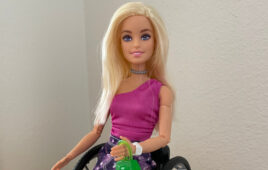
HAND: DEPOSITPHOTOS.COM/ALEXXNDR
Ask clinicians or Assistive Technology
Professionals (ATP) who have worked
with boys with Duchenne muscular
dystrophy (DMD), and they will likely tell
you a similar story: This patient population
is notoriously resistant to changes
in their mobility equipment, including
driving controls and seating.
Behind that opposition is a complex
condition caused by the failure of the X
chromosome to make a necessary protein
called dystrophin. DMD primarily
presents itself in boys, who have one less
X chromosome to work with than girls.
While boys with Duchenne often show
signs of normal development in their first
few years of life, their shoulders, upper
arms, hips and thighs are typically the first
muscles that are weakened by DMD,
according to the Muscular Dystrophy
Association1. The progressive nature of the
disease leads most Duchenne patients to
die in their mid-20s, with some men living
until their mid-30s. This is a significantly longer life expectancy compared to
expectancies for prior generations of
patients with Duchenne MD.
DMD patients will typically require a
manual chair to travel long distances before
moving to a power chair as they enter their
teenage years. By the time they enter high
school, Duchenne boys have been through
years of assessments and are experiencing
the realities of muscle fatigue and atrophy,
as well as cardiac and respiratory issues.
During those teen years, many families
have found mobility solutions that work for
their kids. In turn, patients and parents
alike are concerned that newer technological
options and alternative driving controls
may not give them the same results.
Lisa Rotelli, the Director of Adaptive
Switch Laboratories, said that Duchenne
boys are often misunderstood because
they do not want to speak up for themselves
during an assessment, even if their
current mobility system is uncomfortable
or inefficient because they have been told
what they need over and over again.
“This population is very near and dear
to our hearts because I think they are
misunderstood in many ways,” Rotelli said in an interview with Mobility Management. “When you make big
changes on them, they are absolutely not going to like you, and
sometimes when you make recommendations as well. Their first
word is no, and I don’t blame them because they can’t trust the
outcome. They have things set up that work for them, and when I
make a change, it may mean that nothing will work for them.”
But the difficulties of convincing patients and their families to
try out a new system does not mean that clinicians and ATPs
should give up on providing new technology to this population,
said Gabriel Romero, VP of Sales & Marketing for Stealth Products.
“The thing that I notice the most with Duchenne’s patients is that
they want to move, they want to be independent,” Romero told
Mobility Management. “What I appreciate the most is breaking down
barriers with them and building that confidence and showing them
that there is stuff they can do. They knew they could do it, but they
just didn’t know the technology or needed insight on how to do it.”
Starting with a Standard Joystick
Approximately 15,000 boys in the U.S. are living with Duchenne,
with about 300,000 cases worldwide, according to the research and
patient community nonprofit CureDuchenne2. If those boys have
access to healthcare and complex rehab technology (CRT) providers,
they will usually be in a wheelchair full-time by their teens.
In most cases, boys will start with a standard joystick thanks to
their cognitive and physical abilities. However, Romero said that he
will not always start DMD patients on a standard joystick, particularly
if it’s the first time they are being assessed for a power chair.
“Everyone wants to start with a standard joystick, but there’s a
lot of complexity,” Romero said. “It doesn’t mean that I won’t get
to a standard joystick very quickly.”
While Duchenne boys pick up the steering and speed mechanisms
at a fast pace, Romero will sometimes allow the user to focus
on steering and set up speed settings on the chair with a switch
until the patient is ready to move on to the standard joystick.
“If I can see that they can already do left, right, forward, then
they could pick up a joystick very quickly,” Romero said. “But
don’t sacrifice the process of having successful moments and
putting something there that they could struggle with and start
to develop biases against just because it wasn’t set up properly.”
After starting most Duchenne patients with standard joysticks,
Rotelli said it is crucial to remain cognizant of how to adjust the
system to their changing needs. Mounting the joystick or
alternative driving control in the right place is always important,
but especially with a population that has limited hand dexterity.
Typically, she leans toward light-touch joysticks and fiber-optic
options that require less force and range of motion since the boys
live in the “land of a quarter inch,” as Rotelli puts it.
“A quarter-inch difference makes all the difference to them,”
Rotelli said. “I have worked with many, many patients that can
drive by just moving their joystick forward and maybe to the
right or left. The funny thing is, if you ask them, if they are just
going forward and making left turns and that’s all they can do,
and somebody has to reposition their hands to do right or
reverse, they’re totally okay with that.”
Do’s and Don’ts for Duchenne Tech
As the disease progresses, boys will begin to exhibit cardiac and
respiratory issues on top of their muscular atrophy, making it
even more difficult for CRT professionals to find a mobility solution
that patients can accept and integrate into their daily lives.
The issue is not a fear of change, but how young men develop
habits to make their lives run more smoothly, Rotelli said. In
addition, more advanced Duchenne patients who are headed to
college and building careers feel psychologically opposed to
adopting digital systems because it can serve as a confirmation
that their condition is getting worse, Rotelli said.
“I try hard to show and say: Look at all these things you can do
with these switches or look at all the things you can do with
these different joysticks,” Rotelli said. “We have got to understand
that whatever they are using to control their chair, they’re
also going to be using to control technology — computers,
laptops, phones, games, everything.”
Installing a system of sensors, fiber optics or electronic
switches that do not require sustained pressure is the next step
in the patient’s journey, according to Romero. Stealth offers
precision mini proportional joysticks, including an i-Drive
version that can be programmed through the PWC programmer
or separately through i-Drive software on a computer or tablet.
“We have to understand during the assessment process: Can
they use the joystick to the full capacity?” Romero said. “Is this
just the reality of their usage? Or can we give them something
more simple, something easier for them, that they could use more
abilities and have more independence?”
In addition to introducing the technology, it’s crucial that
parents understand what the technology can do and that they
feel that they have some control over their child’s safety and
mobility, he said.
“The moment parents feel out of control, that demo chair is
back in the garage until they can get back to the clinic,” Romero
said. “They’re not trialing it anymore, and the child is not getting
to practice with it.”
For Rotelli, working effectively with Duchenne patients is also
a matter of determining what technology will not work for their
condition. She is not a fan of using head switches because they
can quickly lead to weakness and fatigue in the necks of some
boys. In the past, Rotelli has also heard suggestions that younger
Duchenne boys should consider molded seating systems.
“That is 100 percent the wrong thing to do,” Rotelli said. “Number one, it’s harder to breathe, and number two, it’s also
harder for access even for a joystick. I lose function the more that
something touches my body and pulls me in one single place. It’s
harder for me to use my hand.”
At the same time, she has also fielded clinician suggestions to
not install tilt and recline on a patient’s chair — a recommendation
she typically rejects because of the importance of “micromovements”
for Duchenne patients.
“If I have tilt and recline on a chair and possibly some anterior
[forward] tilt, you can show them how they can make those
micromovements themselves,” Rotelli said. “Just bring the back
up a little bit, slide their hand forward, and then they can use it.”
Several patients she knows have used tilt and recline to move
their heads off their headrests and sit upright as well as to rest
their heads back onto the headrest. These seat features mimic
muscle control and help with energy conservation, particularly
for boys who spend long lengths of time in their chairs to play
video games, use their phones and move around independently.
Listen, Trust, Repeat
It’s the quality that makes great ATPs great3: the ability to listen
and gather a patient’s history, allowing them to air grievances
with previous seating systems or explain why they are anxious
about using a different driving control. Both Romero and Rotelli
said it was especially important to hear out Duchenne patients
who would benefit from greater independence, but do not want
to change what’s already working for them.
“They’ve seen so many people, from hospital visits to clinical
rehab to outpatient visits to normal school,” Romero said. “They
don’t know you from anything, and so you’re building that
confidence and that trust with everyone. You don’t know the
experiences they’ve had — I could be the guy coming in with a
joystick when the last time they did something with a joystick,
they ran into a wall.”
Romero has had better luck convincing families to switch to a new system when he explains how the patient is only able to
functionally use their current system 80 percent of the time due
to muscle fatigue or other issues.
“As a parent, you need to understand that there are fatiguing
things that are happening, and they need to rest and relax,”
Romero said. “But if I can install something that they can use 100
percent of the time because it’s allowing them to use two parts of
their body instead of using one and only one, there are major
differences in their independence.”
Almost every Duchenne patient Rotelli has worked with since
her first in 1986 has been opposed to any change. Some have
been very adamant about it, requiring extra time and patience to
improve their mobility through a drive control or seating system
they could accept.
Focusing on what the boy wants to do — change a TV
channel, play Xbox, use their phone — and how a system can get
him to that point is the most effective way of overcoming their
initial frustration.
“If I can do this and you have four directions instead of two,
then we have just quadrupled your output to play games and use
computers and text on a phone,” Rotelli said. “That’s usually easier
to get them to buy into than changing their mobility. Then I will
say: I also believe this is an easier way for you to drive your chair.”
Reaching this patient population and transitioning them into
the next phase of mobility solutions requires a willingness to listen
and resist categorizing patients by diagnosis alone, Rotelli added.
“It’s their chair. It’s something they have to use and live in, and
any change is going to be very, very hard,” Rotelli said. “You have
to build a relationship with them, and once you do and have that
trust, then they can tell you what they do and don’t like.”

